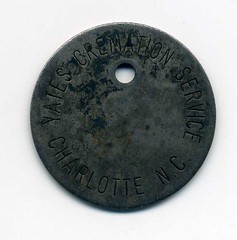
PREV ARTICLE
NEXT ARTICLE
FULL ISSUE
PREV FULL ISSUE
CREMATORIUM IDENTIFICATION TAGSWhile we're on the topic of mortuary science, here's another funeral-related topic. The January/February 2015 issue of the
TAMS Journal (the official journal of the Token and Medal Society) has an interesting article by Heather Schena. With permission, we're
republishing it here. Many thanks to Heather and editor Bill Hyder. -Editor
Crematorium Identification Tags - A Brief Introduction
Crematorium identification tags appear in some collections and online sales described as "tokens" (implying there is some sort of numismatic function). This is understandable since most people do not often see these tags and they have some characteristics in common with tokens. A brief introduction to the appearance and use of these metal tags will educate collectors so they may identify these pieces more readily. The cremation tag in the United States has relatively short history. Jason Engler, Historian for the Cremation Association of North America, states: The crematory token was first invented in the 1930s by a very ingenious cremationist named Lawrence Moore, who was indeed the preeminent crematory and columbarium operator in the country - his Chapel of the Chimes in Oakland, Calif., was the busiest and most successful stand-alone crematory on the continent. The system of positively identifying cremated remains by way of indestructible identification was originally effected with a fireclay tablet. Later, stainless steel tags were created and there are now very few crematories in operation that do not use this system. These tags are used to identify the deceased throughout the cremation process. As seen in the example below, there is a serial number on the tag (2989 in this case) which is written on the paperwork associated with a particular decedent. It is placed inside the door of the retort (cremation oven) during cremation; this is why it looks so worn - it's been exposed to temperatures at 1600°F+. The tag stays with the ashes (cremains) afterwards and is included in the urn when the ashes are handed over to the family. It is either tied to the bag with a twist tie or is dropped into the bag with the ashes. When the cremains are returned to the family they are usually in a temporary container; when they are transferred to a permanent container or if the ashes are scattered the tag can be easily separated from them. 
 To identify this specific example, I found a listing for "Yates Wilburt Vault Co." in Charlotte and called them to see if they were affiliated with the company on the medal only to learn that it was the same company. Yates Cremation Service has contracts with other funeral homes to do their cremations (so a funeral home can offer the service without having to build their own crematorium). This also explains why it was not listed by itself when I did a Google search. They were able to tell me that the date of death for this specific decedent was in 1991. Dan Yates, president of the company, told me that it is no longer their policy to put the name of the company on the tags since (at least in theory) it could be traced back to a specific person, so it will be close to impossible to track down a date or location for these tags in the future. It is worth noting that should a collector find a tag with the name of a funeral home and a serial number, it could be traced back to a specific individual and discretion should be used in determining how vigorously additional information is pursued. The tag blanks I have found for sale are usually stainless steel (brass and titanium are rarer options) with the name of the crematory and the serial numbers engraved by the manufacturer. Stainless steel is ideal since it withstands high temperatures. Higher nickel and chromium contents also mean that many of these tags are not magnetic, though they are still considered stainless steel. Below is an example of a tag prior to exposure to crematorium temperatures; comparing it with the previous example gives some indication as to the stresses endured by the tag.  While these tags are not numismatic in nature, knowing about them and their purpose will assist collectors who may run across one of them in their travels. However, there are a few collectors of these tags who appreciate the importance of their use, and by educating the greater collecting public about them this appreciation can grow. Yates tag photos courtesy of Eric Schena
E-Sylum readers are encouraged to join TAMS for access to a wide range of great articles on tokens and medals. In addition to
John Mutch's regular column on mavericks (unidentified tokens), this issue of the TAMS Journal also has Dave Schenkman's study of
trade token denominations and a piece by Mel Wacks titled Extremely High Relief Chinese Medals Commemorate Imperial Palaces on World Heritage
List. -Editor
For more information on the Token and Medal Society, see:
 Wayne Homren, Editor The Numismatic Bibliomania Society is a non-profit organization promoting numismatic literature. See our web site at coinbooks.org. To submit items for publication in The E-Sylum, write to the Editor at this address: whomren@gmail.com To subscribe go to: https://my.binhost.com/lists/listinfo/esylum All Rights Reserved. NBS Home Page Contact the NBS webmaster 
|